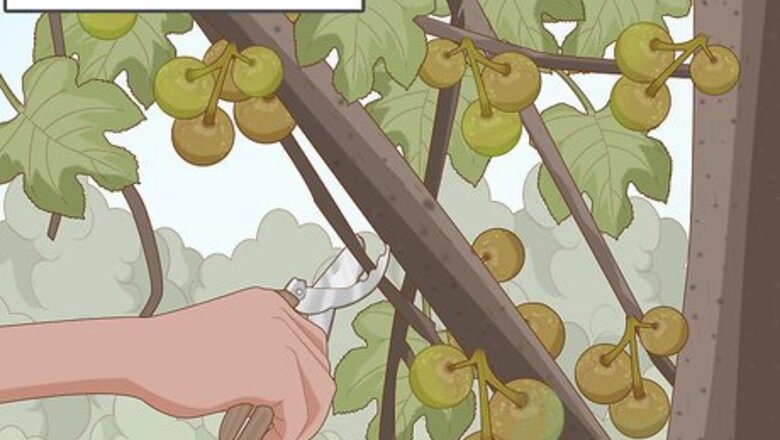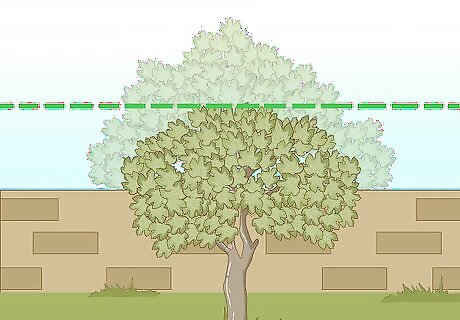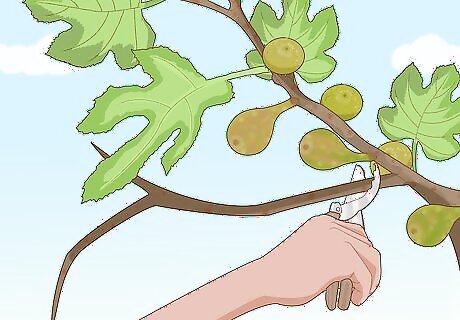
views
X
Trustworthy Source
Science Direct
Online archive of peer-reviewed research on scientific, technical and medical topics
Go to source
Luckily, fig trees are usually easy to take care of as far as pruning is concerned. During its first year or two, a fig tree needs to be pruned significantly to train its growth pattern for the following years. Afterward, however, it can survive with either very little pruning or very elaborate pruning, and it should continue to rebound year after year as long as you keep up on some basic maintenance.
The Beginning Stages

Determine when to do your first pruning. Some sources recommend that you prune the tree immediately after you transplant it. Others argue that you should wait until the end of the first dormant season. Pruning the tree immediately after you transplant it gets the tree off to an early start. You are essentially training the tree from the start to focus its energy in a more concentrated form rather than allowing it to spread its energy out in a diluted manner. As a result, by the end of the growing season, the tree will likely be stronger and better establish. On the other hand, there is some risk of shocking the tree if you trim too much of it away immediately after transplanting it. Most fig trees are resilient and will not fall victim to damage, but if the sapling you obtained is already somewhat weak, pruning it so soon after transplanting it can backfire and cause it to stop growing, and it may even begin to wither. As a general rule, if you trust the source and stock of the tree, you can prune it immediately. If you are uncertain about the integrity of the tree, you may want to wait until the first dormant season before you prune it.

Trim the tree back by half. During the first pruning, you need to clear away a large portion of wood. This is an important aspect of training pruning. By cutting away so much of the fig tree, you force it to focus on developing strong roots. As a result, the tree will establish itself better and be stronger in the long-run. Doing this can also encourage the tree to grow branches horizontally, creating a bushier tree instead of a lanky one.

Prune for fruiting wood the following winter. At the start of the second dormant season after transplanting, choose four to six branches of strong, new wood, and prune away the rest. This process promotes healthier fruit and restricts the height of the tree. At the beginning of the tree's life once you transplant it, most of the fruit is grown on old wood, or branches that have already produced fruit in the past. These branches have less strength now, so you need to promote the growth of new fruiting wood by trimming the old wood away. Choose four to six of the strongest branches, but you should also make sure that they are spaced around the main trunk in fairly even intervals. These branches should be spaced apart widely enough so that they can eventually grow to 3 or 4 inches (7.6 to 10 cm) in diameter without bumping into each other. Note that fruiting branches that grow too close will be unable to reach an adequate thickness, and as a result, they will be unable to support secondary branches or a healthy crop. Such branches also tend to split under stress or in harsh weather. Completely remove all other new shoots or new branches.
Through the Following Years

Do most pruning during the winter. Once your fig tree reaches its third dormant season, or third winter, the vast majority of your pruning should take place during the late portion of the season since the tree is not actively growing during that time period. Wait until after the coldest part of the season has passed, though. Pruning during the winter reduces the risk of shocking or damaging the tree during its early stages of growth, but doing so also makes the process easier since the lack of leaves will make the branches more visible. You could wait to do this pruning until early spring, if desired, but it should be done before the fig tree shows signs of new growth.

Remove suckers growing on the base of the tree. A sucker is a branch that begins to grow from the base or roots of the fig tree. It can look similar to the tree itself but can be identified by the fact that it does not stem from the main branch or trunk of the tree. Suckers result from a tree's attempt at growing more branches, but if the tree is stressed or spliced, it can put out suckers instead of healthy branches from the main trunk. Suckers need to be removed. If you do not prune these branches, they will drain energy from the main, healthy tree, and your fig tree will gradually weaken and produce a smaller yield as a result. Similarly, secondary lateral branches should also be removed if they grow close to the ground. These plants will be unable to adequately support fruit or foliage, so they would only be a drain on the tree's resources if they remained, just as most suckers are.

Cut away dead and diseased wood. If part of your fig tree shows signs of disease, you need to remove those branches to prevent the disease from spreading to the rest of the tree. Similarly, you need to cut off dead or dying wood. Dead wood is unsightly, but more importantly, it can invite disease as it decays. Note that if one of your main fruiting branches becomes damaged, you should remove it and select a newly formed sucker or branch late the following winter as a new fruiting branch for your tree.

Remove branches that do not come from the fruiting wood. New growth that does not emerge from the fruiting wood you designated during the previous growth season should be cut away if you want to continue directing the energy of the fig tree to the fruit produced on those branches.

Trim down the secondary branches. Secondary branches are the branches that grow off the main branches of fruiting wood. Do not remove all of these branches, though. Instead, you need to cut away those that are growing at less than a 45 degree angle from the main branches. Secondary branches growing at a smaller angle to the main branch can eventually grow too close to the main trunk. This positioning can cause problems, and these branches will usually produce weak fruit even though they are still draining resources and energy from the tree overall. Note that secondary branches which have begun crossing or intertwining should be removed for similar reasons.

Consider cutting back the main branches considerably. Usually, you will cut back the main fruiting branches by about one-third to one-quarter their current height. Doing so keeps the tree small and ensures that its resources are more concentrated. The end result is that the fruit produced by your tree during the following growing season will be stronger, larger, and sweeter. While you do not want to over-prune the tree, most fig trees are notably resilient in regards to pruning and can come back stronger and healthier than ever after a significant amount has been removed. If you are dealing with a large fig tree that has not been pruned in several years, you can even cut down the main branches by a full two-thirds without damaging or shocking the tree. If you are not sure about how far to cut back these main branches, just ask yourself how low they need to be in order to make harvesting the fig crop feasible for you. You may not be able to determine an exact height from this estimate, but at the very least, it should serve as a good starting point as you figure out the right height for your tree.

Pinch out new growth during the summer. Allow five or six leaves to grow on new branches during the peak summer months. After these leaves establish themselves, use your fingers to pinch away additional leaves as you spot them emerging. If you do not have a fig tree that produces edible fruit, this step is not especially important. The main purpose in this action is to direct the minimal necessary energy to the leaves of the tree. By removing extra leaves, you stop the tree from directing its energy to them. With less energy directed to the leaves, more energy can be dedicated to the production of fruit.

Remove potentially harmful fruit in autumn. Examine your fig crop during the autumn months. If you spot any large figs that fail to begin ripening, you should remove and discard them. Note that you can leave pea-sized fruit alone, though. This fruit is in an embryonic stage and will not drain resources away unnecessarily. Most fig trees bear their fruit during early summer and late summer. As such, fruit that has not matured by autumn is unlikely to mature at all. As with most other types of pruning, the point of removing fig fruit that will not ripen to maturity is simply to redirect resources to other areas of the tree that can benefit from it more. This is important in the fall since the tree is storing energy and preparing to go into dormancy. Removing fruit that will steal away energy to no benefit can allow the tree to store up more of its energy, thereby strengthening it for winter.

















Comments
0 comment